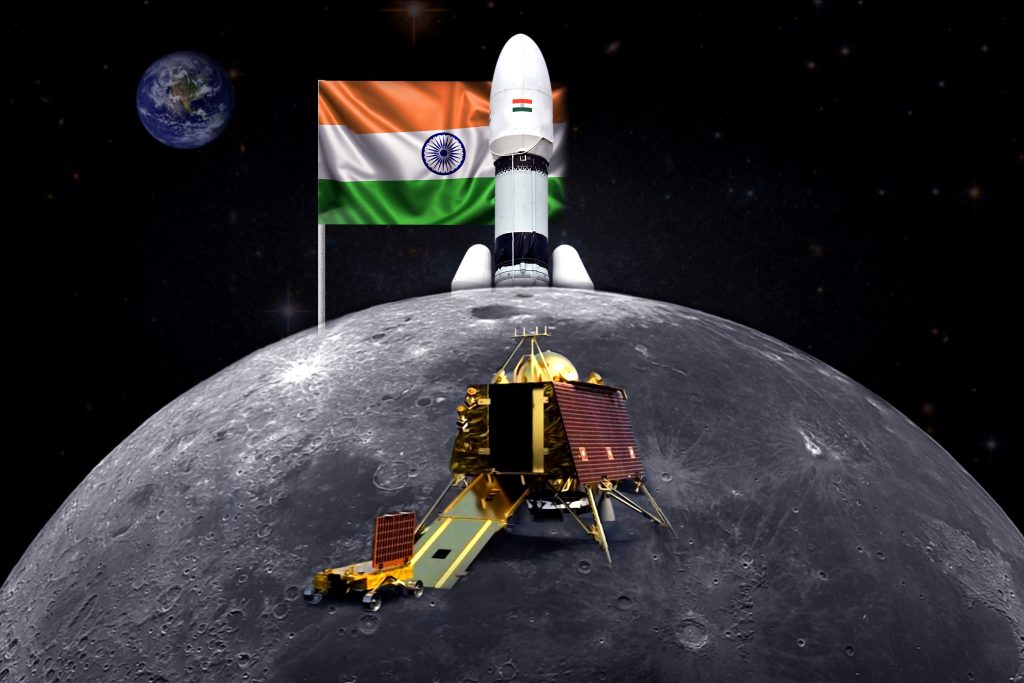Till now, only three countries have ever managed to successfully do a planned landing on the moon. On August 23rd, India proudly added its name to the list with the successful landing of the Chandraayan-3 spacecraft. Not only that, the spacecraft is also the first one ever to land near the lunar south pole. The country’s residents broke out in celebration as the mission’s success was announced officially. The touchdown took place shortly after 1230 BST and 6 PM IST. The entire landing sequence was live-streamed on news channels worldwide, both on television and on the internet.
The Indian Space Research Organization (ISRO), the Indian official authority on everything related to space, has long been known for pulling off spectacular feats on a comparatively constrained budget. As such, when ISRO’s chair, Sreedhara Panicker Somanath, proudly announced that “India is on the moon”, it held tremendous emotional significance for the citizens as well as lunar studies as a whole.
Narendra Modi, the country’s Prime Minister, gave a celebratory statement by saying that “This is a victory cry of a new India”. The head of the state could not attend the landing physically at the ISRO headquarters. He was in Johannesburg, South Africa, attending the BRICS summit. However, he joined in via an online call during the most crucial moments of the landing.

This Was India’s Second Attempt At A Lunar Landing
India had originally planned to do a soft landing on the moon in 2019, through the Chandrayaan-2 spacecraft. However, even if it had successfully managed to reach the lunar orbit, and begin the descent, the mission had ended in failure. The landing sequence involved a complicated maneuver that was controlled entirely by the onboard computer. During the procedure, the spacecraft is supposed to slow down from 3730mph to almost 0. It would also turn vertically from a horizontal position simultaneously.
Any mistake in the thrust and tilt during this entire procedure would be fatal. Too much force and the lander will topple. Too little, and it will fail to reach the targeted spot on the lunar surface. Unfortunately, in 2019, this is the part where everything went wrong. The programming could not change positions properly. As a result, the previous lander had crashed into the lunar surface. It had left the ISRO chief in tears and needing to be consoled by Prime Minister Modi, in a tragic scene.
To learn from and rectify those errors, India launched the Chandrayaan-3 from Sriharikota in the Indian state of Andhra Pradesh on July 14th. The spacecraft reached the moon in 44 days, considerably longer than the ten days the famous Apollo 11 mission required to complete a return journey with humans onboard. The difference is that ISRO’s spacecraft used the moon’s and Earth’s natural gravitational pulls to cover the distance. The Apollo missions had relied solely on direct fuel propulsion. As a result, ISRO’s spacecraft is much lighter in weight.
An Unexpected Race And The Future Of The Mission
Even during this planned program, there was an unexpected surprise in store. On August 10th, Russia’s ROSCOMOS launched Luna-25, the country’s first attempt at a lunar landing in 47 years. Its target was also the lunar South Pole. Moreover, it reached the lunar orbit in a much shorter time – only 11 days. Unfortunately, the landing failed as ROSCOMOS lost communication with the lander hours before the landing could begin. Later, it was confirmed to have crashed.
This had further heightened expectations around the Indian attempt. After the landing, the Pragyaan rover is planned to roll out and conduct surveys on the nearby area for about two Earth weeks or one lunar day. It can take photographs, carry out experiments regarding the origins and geology of Earth, and perhaps most importantly, investigate if there is water ice in the location. If significant amounts of it exist, future manned missions can use the area as a base since fuel and oxygen can be extracted from water ice.
Regardless of the future, India’s success has skyrocketed the country’s claim as a major global power. Possessing the fifth-largest economy in the world and nuclear capabilities, the success aligns with Modi’s nationalistic aspirations to solidify India as a global elite. Furthermore, it is also a marker in the country’s race against neighboring China. It is also making milestones of its own in space exploration.
Keep Reading: China discovers strange glass beads on moon that may contain billions of tons of water
Sources
- “India lands spacecraft near south pole of moon in historic first.” The Guardian. Amrit Dhillon. August 23, 2023.
- “India makes history by landing spacecraft near Moon’s south pole.” Science. Sanjay Kumar. August 23, 2023.

